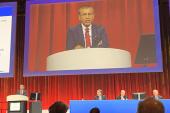REALIZE-K: Potassium Binder Boosts MRA Use in Hyperkalemic HFrEF Patients
Compared with placebo, sodium zirconium cyclosilicate was associated with less need to lower or discontinue spironolactone.

An oral potassium binder taken daily can enable the safe use of mineralocorticoid receptor antagonists (MRAs) in patients with heart failure with reduced ejection fraction (HFrEF) who are at risk for hyperkalemia, results of the REALIZE-K trial indicate.
At 6 months, 71% of patients who received sodium zirconium cyclosilicate (SZC) achieved the primary endpoint of normokalemia on spironolactone ≥ 25 mg/daily without rescue therapy for hyperkalemia compared with 36% of those on placebo (P < 0.001). The study was presented Monday at the American Heart Association 2024 Scientific Sessions in Chicago, IL.
The REALIZE-K researchers, led by Mikhail Kosiborod, MD (Saint Luke’s Mid America Heart Institute, Kansas City, MO), say both the real and perceived risks of hyperkalemia are the primary reason for down-titration and discontinuation of MRAs in real-world HFrEF patients.
“Overall, there were no imbalances in adverse events or serious adverse events. The number of heart failure events, edema, and hyperkalemia events were relatively small, but more participants had such events with SZC versus placebo,” Kosiborod said in his presentation. “And in the post-hoc analysis, this difference appeared to be mostly centered in patients with very high NT-proBNP levels at baseline.”
In the recent DIAMOND trial, another potassium binder, patiromer (Veltassa; Vifor Pharma), also showed that it could improve optimization of renin-angiotensin-aldosterone-system inhibitors in HFrEF patients. That trial was stopped early due to COVID-19 and did not answer the question of how to use a potassium binder to optimize individual HFrEF therapies.
Discussant Larry A. Allen, MD (University of Colorado Anschutz Medical Campus, Aurora), said REALIZE-K “provides important data on the long-term, regular use of these drugs to enable the use of guideline- directed medical therapy.”
But he said that potassium binders should be used cautiously, chiefly because of the significant sodium load in the body that they can produce. This may be more of an issue with SZC than with patiromer.
“There are 400 milligrams of sodium in each 5-gram packet of this drug,” he noted. “And I think that there’s some concern that you see a higher NT-proBNP as well as a trend towards higher heart failure hospitalizations.”
Also important, Allen noted, is the issue of polypharmacy since all other medications a patient is receiving must be taken 2 hours before or after the potassium binder.
REALIZE-K Results
For the study, Kosiborod and colleagues enrolled patients from 85 sites in eight countries who had symptomatic NYHA class II-IV HF and a left ventricular ejection fraction ≤ 40%. Patients either had hyperkalemia at the start of the study (n = 95) or were at risk of developing it (n = 271) due to older age or chronic kidney disease. Kosiborod noted that the population was well optimized on HFrEF therapies other than MRA at baseline, with 99% on an ACE inhibitor, ARB, or angiotensin receptor-neprilysin inhibitor.
During an open-label run-in period, all patients received spironolactone titrated to a target of 50 mg/day. Oral sodium SZC (10 g three times daily) was given in patients with hyperkalemia or at risk of developing it for up to 48 hours to normalize potassium levels and then reduced to a maintenance dose (10 g once daily). Those with normal potassium levels (3.5-5.0 mEq/L) on sodium zirconium cyclosilicate and optimal doses of spironolactone (≥ 25 mg/day) were randomized to continue SZC or switch to placebo for 6 months.
In a sensitivity analysis of the primary endpoint that used a more conservative potassium threshold to define hyperkalemia, 84.8% of patients on SZC achieved normokalemia on spironolactone ≥ 25 mg/daily compared with 50.9% of placebo-treated patients (P < 0.001).
SZC also was more likely than placebo to result in improvements in four of five secondary endpoints: normokalemia on the randomized dose of spironolactone without rescue therapy for hyperkalemia, normokalemia on spironolactone ≥ 25 mg/daily, time to first hyperkalemia episode, and time to first decrease or discontinuation of spironolactone dose due to hyperkalemia.
No between-group differences were seen in quality of life assessed using the Kansas City Cardiomyopathy Questionnaire clinical summary score at 6 months.
Death or worsening of HF occurred in 11% of patients in the SZC group versus 3% in the placebo group (nominal log-rank P = 0.034). One cardiovascular death was reported in each group, while HF events were higher in the SZC group (10% vs 2% in the placebo group).
In a post-hoc exploratory analysis, adjudicated HF events occurred in seven of 24 patients in the SZC arm versus one of 16 in the placebo group, but among those with NT-proBNP levels ≤ 4,000 pg/mL, adjudicated HF events occurred in three of 75 SZC participants versus one of 80 placebo-treated patients.
At 6 months, NT-proBNP levels were higher in the SZC group compared with placebo, but the difference did not reach statistical significance (P = 0.061). Additionally, there was no difference between the groups in daily dose of loop diuretics.
A major concern for patients and physicians moving forward, said Allen, is the cost of the potassium binder.
“With insurance, coverage in the US is variable—preauthorization is typically required and a copay can be significant. Without insurance, this drug in the US costs $10,000 per year,” he added.
Allen further said that it will be important to produce data on patients who are truly high risk for hyperkalemia and need to add another medication to their regimen versus those who can be managed with diet and blood tests to limit polypharmacy and added drug costs.
L.A. McKeown is a Senior Medical Journalist for TCTMD, the Section Editor of CV Team Forum, and Senior Medical…
Read Full BioSources
Kosiborod MN, Cherney DZI, Desai AS, et al. Sodium zirconium cyclosilicate for management of hyperkalemia during spironolactone optimization in patients with heart failure. J Am Coll Cardiol. 2024;Epub ahead of print.
Disclosures
- REALIZE-K was funded by AstraZeneca.
- Kosiborod reports research grants to his institution from AstraZeneca, Boehringer Ingelheim, and Pfizer; consultant/advisory board fees from 35Pharma, Alnylam, Amgen, Applied Therapeutics, Arrowhead Pharmaceuticals, AstraZeneca, Bayer, Boehringer Ingelheim, Corcept Therapeutics, Cytokinetics, Dexcom, Eli Lilly, Esperion Therapeutics, Imbria Pharmaceuticals, Janssen, Lexicon Pharmaceuticals, Merck (Diabetes and Cardiovascular), Novo Nordisk, Pfizer, Pharmacosmos, Regeneron, Roche, Sanofi, scPharmaceuticals, Structure Therapeutics, Vifor Pharma, and Youngene Therapeutics; other research support from AstraZeneca and Vifor Pharma; and honoraria from AstraZeneca, Boehringer Ingelheim, and Novo Nordisk.





Comments